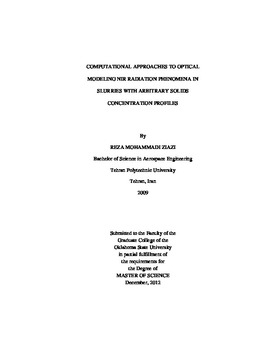| dc.contributor.author | Mohammadi Ziazi, Reza | |
| dc.date.accessioned | 2014-04-17T19:53:15Z | |
| dc.date.available | 2014-04-17T19:53:15Z | |
| dc.date.issued | 2012-12-01 | |
| dc.identifier.uri | https://hdl.handle.net/11244/10001 | |
| dc.description.abstract | Near infrared sensors project light into particle-laden flows and use light returned via diffuse reflectance and scattering phenomena to measure solids concentration and chemical composition. An important measurement parameter is the depth of penetration returning the light used in the measurements. In this work several optical modeling approaches were evaluated for predicting the depth of penetration of near-infrared (NIR) light in slurry flow in a pipe. The goal was to find a model suitable for predicting the depth of penetration for slurry flows with arbitrary solid concentration profiles. The models which were considered fall in two categories; continuum and discontinuum theories. Continuum models consider the sample as one integral layer while discontinuum models divide the sample into layers one particle thick. Hence, discontinuum models are well suited for slurries with varying concentrations which can be adjusted layer by layer. The continuum theories used were Shuster, Kubelka-Munk, radiation transfer, three flux, and diffusion. The discontinuum theories used were plane parallel layer, assembly of sheets, and representative layer theory. Discontinuum models were applied to cases which included uniform, hypothetical, and realistic concentration profiles predicted using Computational Fluid Dynamics (CFD). For the CFD predictions, the slurry was xylene liquid and ADP solid flowing in a 50.8 mm diameter horizontal pipe at mean velocities between approximately 1.8 and 4.0 m/s, corresponding to Reynolds numbers between 1.2x105 and 2.8x105. Monodisperse spherical slurry particles with diameters ranging from 38 to 150 microns were considered with solid volume fractions ranging from 5% to 35%. Numerical versions of the optical models were created for the theories using MATLAB R2012a. Each model simulated the passage of NIR radiation through the sample based on light fractions. Light fractions were computed for each layer of the discontinuous models, and the depth of penetration was evaluated. Validation was performed with results in the literature for optical experiments for similar cases. Comparisons of the results suggest that the discontinuum theories are more accurate than continuum theories for these applications, with representative layer theory used with Stokes formula providing the best results. It is concluded that the models are suitable for predicting the depth of penetration for NIR measurements. | |
| dc.format | application/pdf | |
| dc.language | en_US | |
| dc.publisher | Oklahoma State University | |
| dc.rights | Copyright is held by the author who has granted the Oklahoma State University Library the non-exclusive right to share this material in its institutional repository. Contact Digital Library Services at lib-dls@okstate.edu or 405-744-9161 for the permission policy on the use, reproduction or distribution of this material. | |
| dc.title | Computational Approaches to Optical Modeling Nir Radiation Phenomena in Slurries with Arbitrary Solids Concentration Profiles | |
| dc.type | text | |
| osu.filename | MohammadiZiazi_okstate_0664M_12575.pdf | |
| osu.college | Engineering, Architecture, and Technology | |
| osu.accesstype | Open Access | |
| dc.description.department | Mechanical & Aerospace Engineering | |
| dc.type.genre | Thesis | |
